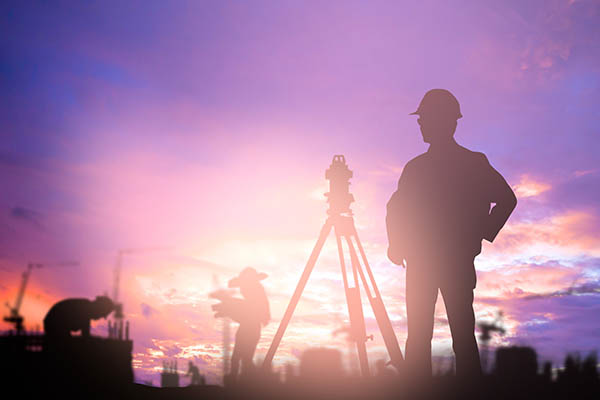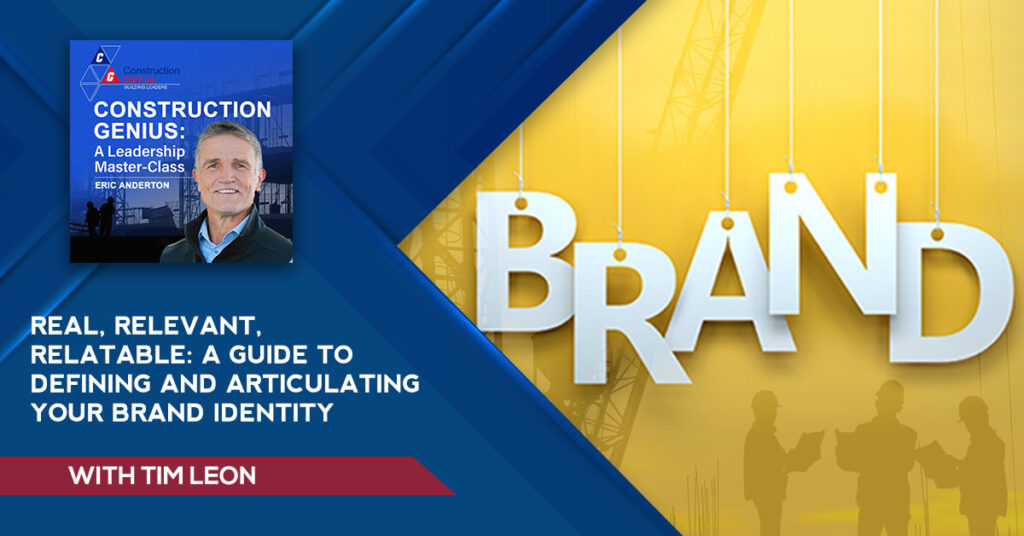Your brand identity is your unique claim of distinction. Therefore, you and your entire team must have clarity on how you want to present it to your target market for it to be truly meaningful and impactful. Eric Anderton chats with Tim Leon, President of Geile/Leon Marketing Communications, about the many things to consider when establishing and maintaining a consistent brand identity. Tim explains how to effectively communicate brand positioning and promise to both clients and employees, making it relevant and relatable. He talks about holding branding sessions to constantly improve your messaging and sales strategies. Tim also tackles the nine triggering events that signal a need for a complete rebranding to avoid getting left behind by your competitors.
—
Watch the episode here
Listen to the podcast here
Real, Relevant, Relatable: A Guide To Defining And Articulating Your Brand Identity With Tim Leon
When it comes to building the projects that you work on every day, what does your company deliver better than anyone else? The reason I’m asking you that question is because if you can get clarity on that, you’re on the road to beginning to understand what your brand is. Your brand is your unique claim of distinction. It’s important for your company to be able to clarify your brand so that you can attract the right kinds of clients to your business and the right kinds of employees. In order for your brand to be meaningful and effective though, it has to be believable and relevant to both your customers and your employees. In this episode, we dive into everything branding.
My guest is Tim Leon. He is the president of Geile/Leon Marketing Communications, which is a full-service brand-driven marketing communications firm in St. Louis, Missouri. He serves as the brand strategist and works with clients on branding, rebranding, and brand refreshes across multiple industries, including construction. We’re going to have a no-jargon discussion here about branding, specifically how you can clarify that brand of yours and communicate it so that you get the right kinds of clients and employees in your organization. Enjoy my conversation with Tim. Share it with other people. Thank you for tuning in to the show.
—
Tim, welcome to the show.
Thanks, Eric. It is great to be with you.
I love bringing on people who are specialists in particular areas that I know my clients and my audience want to learn more about. You are a specialist when it comes to branding. What do you mean by branding?
That’s a great question because there are a lot of interpretations. When we, as a marketing firm, talk about branding, I define it as an organization’s unique claim of distinction. What makes you compelling to your customers? That can be in the words you use and the visual expression of what your brand or logo looks like. It’s everything that makes you unique to the customer.
Why is that important? You are talking in terms of words, visuals, and logos. Most of the people here are thinking about moving dirt, laying foundations, and building structures. Words, visuals, and logos don’t necessarily go into that.
When I think of a brand for a construction company, your brand is an asset no different than the trucks that your workers drive or the office building. It is an asset, and that asset brings value to the company. Interestingly enough, we do a lot of work with companies that may be looking to sell their business. There’s a ton of research out there that states that a strong brand can add value to the purchase price of a company. I find it interesting. This is not your category, but I saw that when Amazon bought Whole Foods, 70% of the purchase price and value was in the goodwill of the Whole Foods brand. It’s very important to the value of the company.
A strong brand can actually add value to the purchase price of a company. Click To TweetThe other thing is in your industry like many others with the shortage of skilled workers, from a recruitment standpoint, the landscape has changed. Prospective employees don’t just want a job. They want a job with the right company. They want a job with a brand that has a culture and that stands for something. Branding can be very important from a recruitment perspective as well.
That’s interesting. When it comes to messaging words, visuals, and logos, you’ve got a client-facing brand. The purpose of that is for them to know you, trust you, like you, and want to do business with you. What you’re describing as an employee-facing brand, is it the same brand? How do you distinguish between those two things? Let’s say you buy into this idea of branding and you’re looking to establish that brand. How do you distinguish between those two aspects of it?
It’s what you said, externalized branding and internalized. Are they related? Absolutely. Is it the same brand? It is. The thing I would tell you is in the service industry specifically, the people who work for you are really the expression of your brand. They are the ones out there customer-facing. They’re the ones representing what your brand promises to deliver. My belief is you have to have employees who believe in your brand positioning and the value and understand the importance of their role in delivering the brand promise. If you promise that I’m going to deliver a construction project on time every time, the people that you hire are the people who are going to make that happen. I believe there’s a direct correlation.
It’s interesting. You used the phrase brand promise and brand positioning. I know the guys and gals in the field are probably not thinking in terms of that. How do I effectively communicate to my employees my brand positioning and brand promise in ways that they can understand?
Companies are very good at having external communications marketing programs, but they don’t think about an ongoing internal communications program. That could be as simple as a monthly or bimonthly employee newsletter. I’ve done work for clients in the construction category. What does the job site signage look like? Are we reminding people about the brand and what we deliver on a project?
We’ve done things where we’ve had the president of a construction company go out to the sites and do a brown bag lunch and talk to the employees about how important they are to the brand and to the company. It’s an ongoing communication. Your point’s well taken. It’s not a one-and-done. Like you do with your external marketing, internally, are you communicating on an ongoing basis about what your brand stands for and what you expect your employees to help deliver day in and day out to live up to those brand standards?
If a brand is an organization’s unique claim of distinction, how can I begin to clarify what is my unique claim of distinction as a construction company? How can I begin to shape and understand this branding message?
It starts with having what I would call a branding session with your key leadership, let’s say. We do this for clients, but you don’t have to hire an agency to do this. You get in a room and talk about what makes you unique. Here’s what I would say. A lot of people say, “We all do the same thing.” Maybe that’s true, but you do some things better than your competition.

You really need to distill down what I call a brand positioning. Maybe it’s a brand theme or a brand promise that says, “At ABC Construction, what we deliver better than anyone else is blank.” You come up with that declaration or statement that maybe you deliver projects on time and beyond client expectations every time. That’s a big promise. You then have to ask yourself, “We deliver that. How do we do that? How can we support that?”
Any strong brand positioning has to have some support points, like, “We do that because we have a proven process on how we’ve managed projects.” You come up with these reasons on how you can deliver that position better than anyone else. That becomes the essence of everything you do. You look at everything you do, “How does adding this marketing campaign and getting ready to do support my brand positioning?”
You’re putting an RFP together for a big project you’re going after. What do you say in that first paragraph when they’re saying, “Tell me about your company?” It should be really focused on your positioning on what you do better than anyone else. It’s putting brand first, thinking about every time you get in front of a client or a prospect, what are the first things you’re going to say about your company. It needs to come down to, “Why us? What makes us better? What do we do better, and how do we support that?”
Let me take you into that meeting where, let’s say, I’ve got my leadership team. I’ve identified a couple of questions here to help clarify my brand. The first one is, “What do we deliver better than anyone else?” The second one is, “How do we do that?” What are some other specific questions that I might ask in that leadership meeting to help clarify my brand?
One of the things you would ask is, why do I come to work every day? What drives me to work for this company I work for? That’s getting really visceral. Maybe it’s getting a little into the culture. A lot of times, that’s the distinctive nature of a brand. Sometimes, it’s the culture. You want to ask thought-provoking questions like that. The other question you have to ask yourself is, in my competitive set, and you pick 2 or 3 competitors, where are the weak links in their positioning that I can take advantage of? Sometimes, that’s how we get to a strong brand position. We do things better than 2 or 3 of our competitors. We hone in on that. You got to get into a competitive analysis a little bit. Those are a couple of ways to get there.

That’s interesting, that competitive analysis. Perhaps you have a way of bidding work that’s a little more creative than your competition and that gives the customer some advantages. Perhaps you adopt technology in a way that’s more cutting-edge than your competition and that helps you to build more productively. Those are all areas to be thinking about in terms of getting work, building work, and even how you handle your customers in terms of payments and things like that. Those are all things to consider when you’re articulating your brand position.
You’re right. It should impact every part of your operations. One other point I would make is once you, as a leadership team, have developed this positioning or positioning statement, I would validate it. What I mean by that is I’d get 2, 3, or 4 customers in a room together or maybe on the phone and say, “Here’s what we think makes us unique and why you, as a customer, work with us. Is that believable? Do you believe we do that better than anybody else?” Make sure from the customer’s perspective that they’re buying into this. I always say a good brand positioning is believable, meaningful, and relevant to the customer. It resonates with what the customer cares about.
I want to talk about that more, so believable, meaningful, and relevant to the customer. Let’s say I did schedule some interviews with my customers and I had 5 or 6 questions I wanted to ask them. What if I didn’t tell them in advance, “This is what we’ve come up with,” but merely ask them what their view is and see how that might differ from what I’ve come up with?
That’s a very good idea. You want to understand what the current brand perception is. That’s why you have to validate it. You might be onto something that internally everybody thinks is great but the customer’s like, “That’s not what I think about when I think about you guys. I think about this.” It can really impact believability. You don’t want to fight. If it’s a positive perception, how can you leverage that? It’s a great idea. You’re right. You don’t have to lead the witness. The more you can get them to talk honestly is great.
It’s interesting when I’m on LinkedIn. LinkedIn is a place where a lot of people hang out for business. It’s a tremendously dull, boring website, but nevertheless, we make connections there and we do business over LinkedIn. How do you advise companies to position themselves brand-wise in terms of how they present themselves to the world? How genuine should someone be in their brand positioning?
The more authentic and genuine, the better. A lot of people, when they’re on LinkedIn, they want this polished appearance. They want it to be the right words. My belief is if your brand is grittier or you’re more plain-spoken, you really need to let that style of your brand reflected in how you do your LinkedIn. If you look at my LinkedIn, when I describe what I do, I talk about how I help companies make it mean something. I help them find their unique claim and distinction and bring it to the world. That’s what I do.
That’s not this flowery over-the-top statement. The simpler and more clarity you can bring to your LinkedIn, the better when you describe the company, especially on your personal. I always tell people, “Your personal LinkedIn, when you talk about who you work for, should be consistent with how the company is talking about it. The brand position should be very similar.”
What’s the biggest mistake that construction company owners make when they’re going about this branding process?
I touched on it. The mistake they make sometimes is not validating it with the customer. They are going forward organically. We think, “This is great. It happened in this conference room. We’ve got this theme line and this position,” but we forget about who it needs to resonate with. What I want to advocate for these business owners, because I am a business owner, is we don’t have time or money to go out and hire a research company. I call it the voice of customer research.
Get on a phone with 3 or 4 customers, not your good customers, but talk to a new customer. Talk to a customer you’re trying to get in to see. Get them to talk about, “I like what you’re doing,” or, “No, I don’t.” That’s the kind of validation that helps level set a company and get them off to the right track with their positioning in the company or their brand that they’ve talked to customers.
I would agree with that. It’s really important for those customer conversations to take place. What I encourage my clients to do is to develop what I call the avatar. The avatar is the one person who is their target audience for every single piece of marketing that they have. You may have that internal avatar, which is the person that you want to hire. You may even divide that between, let’s say, someone who’s in the office and someone who’s in the field. You’re very clear on who you’re speaking to in every piece of your marketing material because if you’re not, then your message becomes diffused and it loses a lot of its impact. Do you think that’s along the right lines there?
Yes, I do. You are spot on. One of the other mistakes that owners make is your brand is not for everybody. You mentioned it. You’ve got an audience. You need to be true to who you resonate with. My belief is that all things to all people do not work. Having that avatar to say, “Here’s who I want as a customer,” is very important.
One of the mistakes business owners make is building a brand for everybody. Instead, you have to pick a particular audience, identify your avatar, and fully resonate with them. Click To TweetOne of the things that oftentimes construction companies get hamstrung by is that they do the right projects in the right locations but for the wrong clients. The reason why they’re working with the wrong clients is that their branding hasn’t been specific enough to attract the right clients and repel the wrong clients. If you think about reasons why people choose not to do business with a construction company, what role in branding brings those things up and deals with them upfront? What’s taking those objections about why people don’t do business with you and then addressing those objections so that they’re alleviated and people feel more comfortable working with you?
I’m sorry. Can I have that question?
Let’s say I’m looking to buy construction services. One of the reasons why I don’t want to buy construction services or I’m fearful when it comes to it is that I’m not an expert so I’m going to hire this construction company and they’re going to hose me on change orders because of my ignorance. They’re going to take advantage of my ignorance. I’m going to have to pay a lot more money than what I agreed to in the contract simply because of the change orders. Let’s say I’m the construction company and I know that people don’t want to get change ordered to death. Is that something that I bring up in my marketing and in my branding so that people who have those concerns have that issue addressed upfront?
I see where you’re heading. I would say this. Some of the strongest brands in a category are the brands that go against the preconceived perceptions of the category. Think about banking, credit cards, and high interest rates. There are companies like Capital One with credit cards. They built their brand around doing it differently. When a construction company can address those preconceived notions in their brand and pretty much say, “We’re not like the run-of-the-mill company you’re used to doing business with,” that is a very hard, challenging position. If you can own that and put processes in place to make sure you’re delivering on it, that can be powerful.

What role do testimonials have in my branding?
Some brands, I call experiential brands. Meaning, what makes them distinctive and unique is the experience of working with them. That’s true in service categories and in the construction category.
Can you give me an example of a brand that’s like that? It doesn’t have to be in construction. It is so that we get a hook on what you’re talking about.
I’ll use a client of ours if that’s okay.
Sure, please.
There’s a company here. They’re headquartered in Chicago, but they have offices in St. Louis as well called Clayco. They’re a national design-build firm. In 2010, they were coming from being local to becoming a national player in the design-build space. What were selling and what they were good at was they felt like they were building the structures that were making a difference to the world. Meaning, they’re in life sciences and they’re doing stuff in environmentally clean battery plants. They felt like, “We’re doing projects that have an impact way beyond the structure.”
We came up with this brand for them, which they’re still using fifteen years later, called Beyond These Walls. The idea is we’re building the structures that are positively impacting society in immense ways. There is a positioning. It’s a tough one to deliver, but they put in the work and investment to do that. They’re targeting the right types of companies. They put processes in place to make sure they are building those kinds of buildings. They’ve got a portfolio to prove it. That, to me, is a great example of the company that’s doing that.
That’s interesting. You mentioned they’ve put processes in processes in place. When we’re talking about branding, we’re not talking about a fancy logo, your website, or some sort of fluff. We’re talking about the substance of your business. Am I hearing that right?
Absolutely. It’s a great point. A lot of times, in that branding session we talked about earlier, somebody will say, “We are delivering on that particular benefit to the customer but we’re not doing it as well as we could.” A lot of times, a to-do list will come out of that branding session. It is like, “If we’re going to try to live this brand position, we’ve got to put these three things in place,” which could be very operational in nature. It could be, “Do we have the right project management system to really ensure we’re keeping clients informed along the way, managing expectations, delivering work on time, and change orders aren’t a problem?” If you’re delivering on the brand experience, better reflect that brand position. It’s a great point.
I have clients who’ve been around for over 100 years. Businesses change. They develop. They grow. There’s branding and then there’s rebranding. How do I know it’s time for a rebrand? Maybe I get bored with my logo and I want to change it all up, and then people say, “What are you doing?” What is rebranding? Why is it important? How do I know when to do it?
I call it a brand refresh. A brand is like, “I’m getting a full facelift.” A brand refresh is, “I’m getting a facial. I’m going to improve on a few things.” Usually, what happens is there’s something about the brand that isn’t resonating. The brand is not as relevant as it once was. You mentioned that it can be simply our marketing materials and our logo are outdated. We don’t look like we’re the company we say we are. Graphics like that can cause it.
What I see more often is new leadership. Somebody comes in to run the company, the next generation, and they have a different vision. Your brand has to reflect that leader’s vision. For all of your owners, whatever that vision is, the brand should reflect where they’re going. That’s a lot of times a change in leadership. A lot of times, it is markets. You went into different markets. Maybe it’s geography. You’ve always been in the Midwest and you go into the Southeast. That brings a whole set of challenges because no one knows you out there.
Your brand has to reflect your leader’s vision. Whatever it is, it should reflect where you are going. Click To TweetNew markets, a lot of times, are a reason to do a refresh. Maybe you’ve acquired a company. There are two companies coming together. You got to come back and say, “What does this merged company stand for?” Those are all triggering events, and there’s more than that. If you go to our website, the first thing that will pop up on the homepage are nine reasons you might need a brand refresh. These are the triggering events we see over and over again on why companies visit doing a refresh with the brand.
Walk through those nine. Give us the nine right off the top there, please.
Here are some of those triggering events when people might want to consider a brand refresh. Has your company been acquired or have you merged with another company? That’s always a biggie. New leadership brings a new vision. Are you reflecting on that? Have you entered a new market, a new industry, or a new geography? That’s always a biggie.
There is the geographic footprint where you go from local to regional. What does that look like? I talked about it since the pandemic. There are lots of changes in how consumers shop and consume. There are changes in consumer behavior and how they shop for construction services. Have you expanded? Do you have a different service line? Are you offering design-build and you’re getting into architectural design? Anytime you do something like that, expand a service offering.
Your graphics logo, are they outdated? Are you no longer feeling like you’re current? Maybe it’s your brand messaging. You feel like it is tired and your customers are glossing over it. It’s not resonating. Finally, a competitive threat. You have a new competitor in the market that might be getting into your shorts a little bit. That’s always a biggie. Those are the nine.
That’s excellent. When I go about doing that refresh, how long should it take for me to go from the executive team discussion to any of the changes that I make on my website and all that kind of stuff?
I tell people, “Expect that to take three months if you really do it right.” If you think about it, if you’re going to validate it with customers, you want to do a little research in there. I always say when you’re introducing a brand or doing a brand refresh, what does the internal communications look like? I would always want to do that first before I would start externalizing it with marketing. It is making sure your employees and subcontractors understand where this brand is going. By the time you all get that done and you launch externally, my guess is you’re three months out.

That’s excellent. Tell us a little bit more about your company and how folks can get in touch with you.
Our company is Geile/Leon Marketing Communications. We’re in St. Louis, Missouri. We’ve been in business for many years. The best way to get in touch with us is to go to our website, Geileon.com. Please visit me on my LinkedIn page at Tim Leon. I’m on LinkedIn. I’m very active there. That’s a great place to get ahold of me. You can email me. I’m still doing email. It’s [email protected]. I’m happy to talk to anybody like we had in this conversation with any of your audience regarding any branding questions they might have.
That’s great. Tim, I really appreciate your time. Thank you for giving us the insights. Thanks a lot.
I really appreciate it. You have a great show and I’m honored to be a part of it.
Thank you. I appreciate it.
—
Before you bounce away, thank you for tuning in to my discussion with Tim. Also, go out to wherever you get your shows and give this show a rating and a review. The reason why I’d like you to do that is because when you give the show a rating and a review, it helps the show to be seen when people are searching for construction shows. I promise you people are searching for them. I’d love to get your feedback on the show. As a result of that, we have more people that are able to enjoy these interviews. I really appreciate you tuning in. I hope to catch you on the next episode. Thanks again for tuning in to the show.
Important Links
- Geile/Leon Marketing Communications
- Tim Leon – LinkedIn
- [email protected]
- Eric’s book. Buy it now! Construction Genius: Effective, Hands-On, Practical, Simple, No-BS Leadership, Strategy, Sales, and Marketing Advice for Construction Companies



